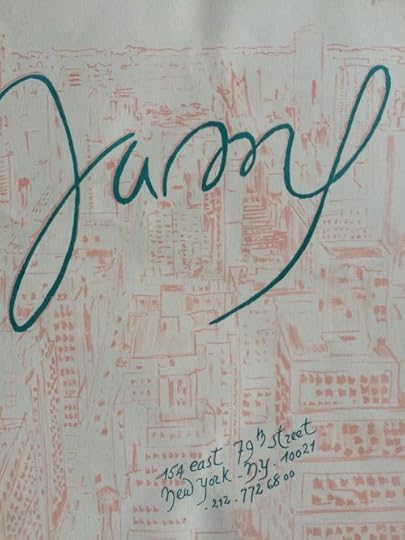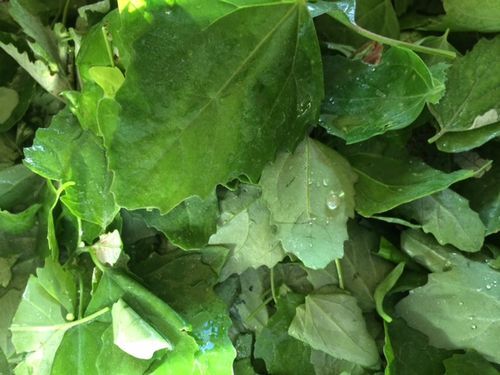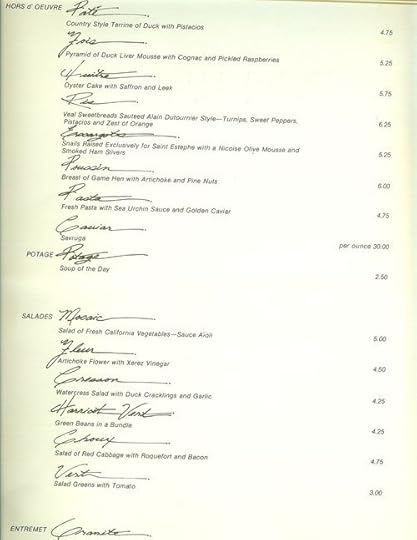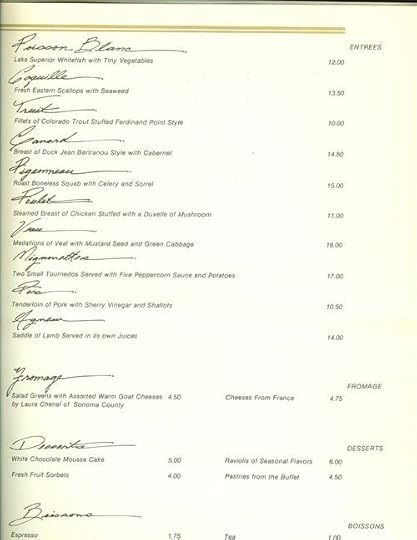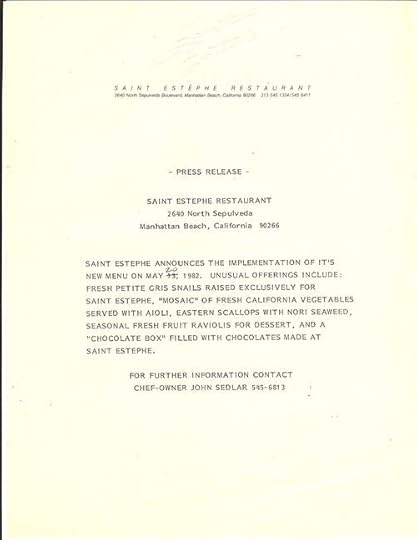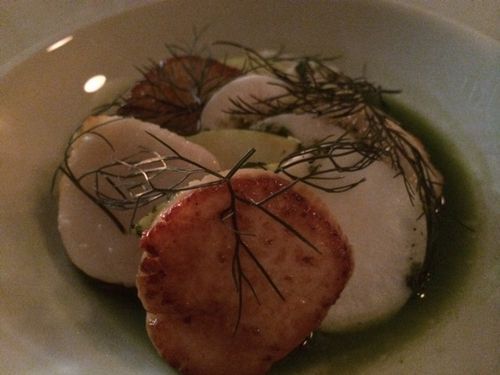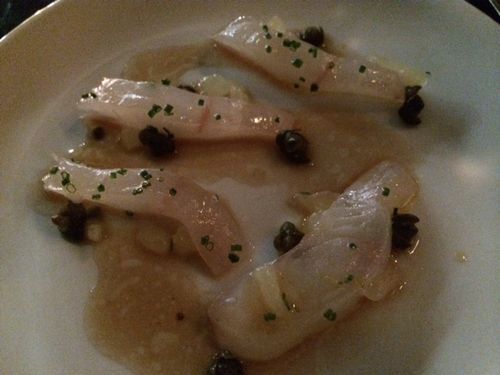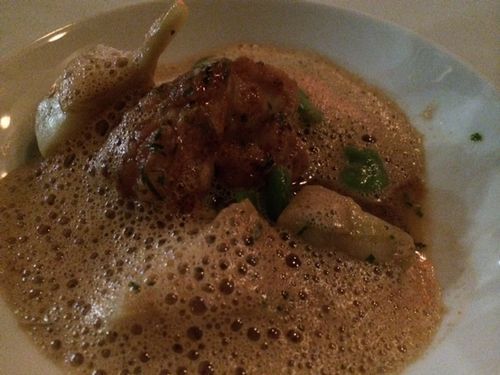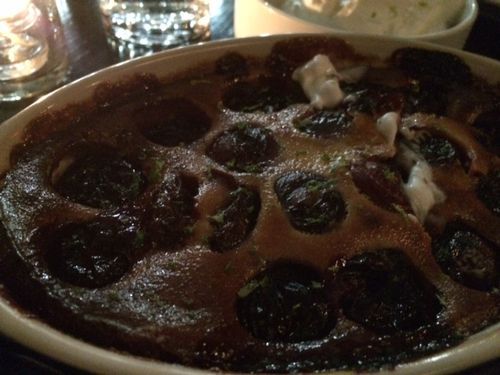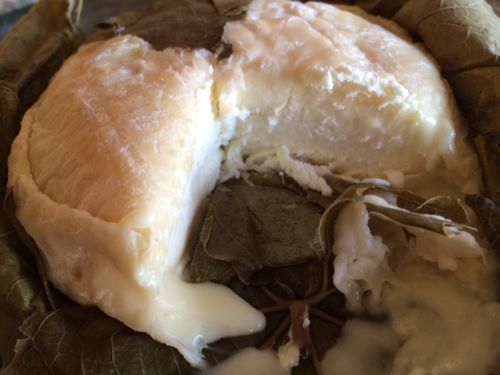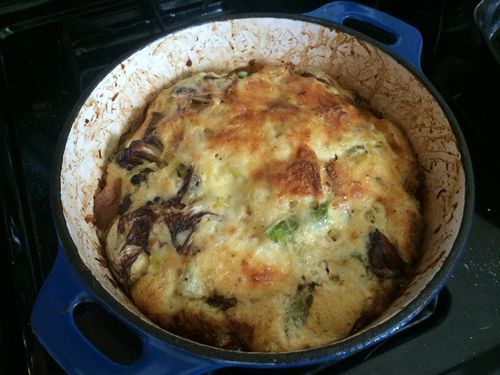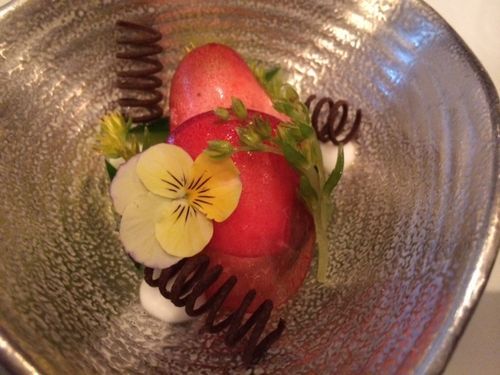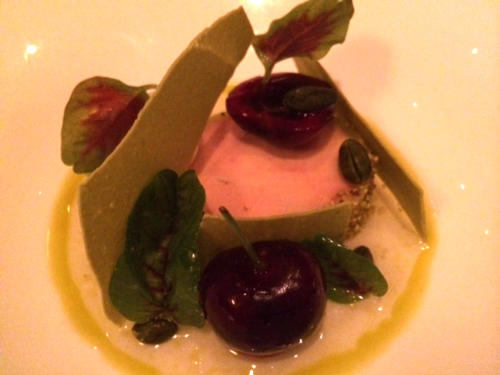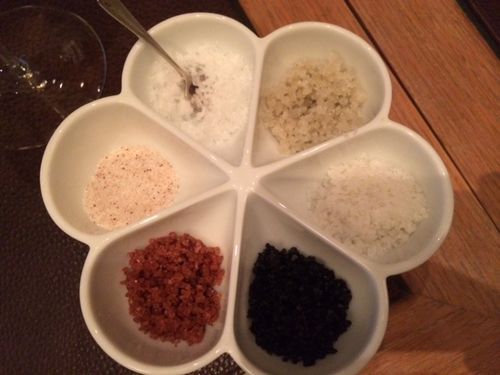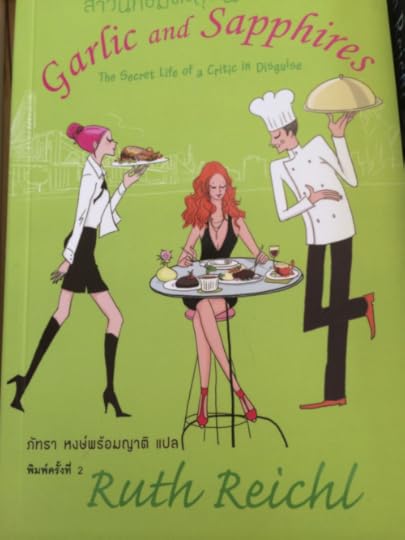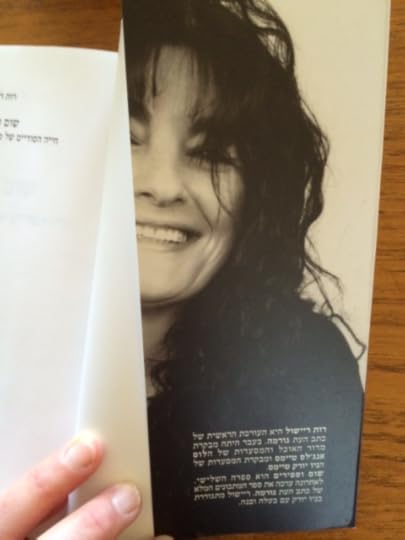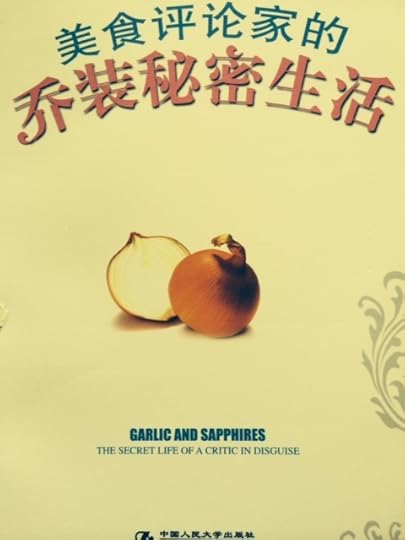Ruth Reichl's Blog, page 9
June 15, 2015
Kick Out the......
Another menu offering from the box in the coat closet, this time from Jonathan Waxman���s seminal Manhattan restaurant, Jam's. Jonathan had been the chef at Michael's in Santa Monica, and when he arrived in New York he brought California cuisine with him. Free range chicken? Check. Laura Chenel���s goat cheese, FedExed from the West Coast every week? Check. You get the idea. (Jonathan's West Side restaurant, Bud's, was the home of Paul Prudhomme's pop-up Cajun restaurant, which explains that grilled swordfish with spicy pineapple salsa.)
But Jams brought more than the simplicity of an ingredient-driven menu to New York. The restaurant became a clubhouse for New York���s gonzo 1980s chefs. There was famous art on the walls, the servers wore sharp white shoes, and expensive champagne was freely poured, starting at breakfast.
One mouthful of that air - thick with fun, exuberance and excess - and you found it hard to leave. But the fun finally ran out; Jams closed in 1990.
Without further ado, here���s the menu from Tuesday August 20, 1985. The prices kind of amaze me; I had lunch at Jonathan's current restaurant, Barbuto the other day, and the chicken cost exactly one dollar more. Thirty years have passed since then, and you might want to recall that in 1985 the minimum wage was $3.35 an hour.
Lest you think the place teemed only with the young and the hip, note the message at the bottom of the menu. When was the last time you saw somebody smoking a pipe?
June 14, 2015
Wonderful Weed
Lamb's Quarters
A friend who was weeding her garden yesterday gave me an entire bag of lamb's quarters, and I practically danced for joy. It's my favorite forage - a gentle, easy to cook green that is not called "wild spinach" for nothing.
Unlike so many other foraged finds, it's easy to clean. Simply dump it into a sinkful of water and pull it out; these leaves do not cling tenaciously to dirt, and the gritty pollen washes right away. Pull off the longest stems - you'll know which - but don't be fussy about it. The stems pretty much vanish as they cook.
You don't need to do much. I melted some butter, threw in the lamb's quarters for a couple of minutes, watched them wilt, added a bit of salt (the leaves are naturally high in sodium), and a splash of lemon (which neutralizes the oxalic acid). Then I sat down to a totally delicious plate of greens.
If somebody offers you lambs quarter's, do not turn them down. They're extremely delicious - and their vitamin and mineral content make these among the most nutritious of wild plants.
June 13, 2015
Old Menus
Just found a box of old menus - from my days at the Los Angeles Times - hidden in a box in the closet.
I've been trolling through them, which is like encountering old friends. Here is early Thomas Keller, and his fascinating menus from Checkers. And the inaugural menu from the much-missed Rex, which I still consider the most beautiful restaurant I've ever visited. (The dining scene from Pretty Woman was shot there.) And here, in all its laminated glory, is Michael Roberts' menu from Trumps; it's at least thirty years old, but still so modern you could change the prices and offer it up today without anyone finding it strange. Was there another high-end restaurant in the country whose menu offered Tacos, BBQ brisket on a bun, tuna pastrami, fried chicken, salmon tartar, chicken with spicy peanut sauce, french toast with bacon and fruit donuts on the dinner menu? I'd guess not. Michael, who passed away ten years ago, was one of the most interesting chefs in the country, cooking to some interior music no one else could hear.
I'll be posting menus now and then, as I find them. But for today, here's John Sedlar's menu at St. Estephe from 1982. He's been a pioneer of Southwest cooking - but as this menu makes clear, so much more. Isn't it amazing to see a recipe for pasta with sea urchin sauce from a time when most Americans had not the faintest notion that those spiny creatures even existed? And just look at that price! (John was also the first chef who ever served me American caviar and home-grown snails.)
June 10, 2015
Loved the Food
Walking down the Bowery I'm always surprised by what's happened to my old neighborhood. When I lived on Rivington Street, in the early 70s, the neighborhood was so dangerous, depressed and dilapidated the police didn't bother with it, and if you had a car you could park it for weeks without worrying about tickets. Nobody, of course, had a car. And if they did, the Bowery bums - who were still very much in residence - were always trying to "clean" the windows with their rags.
So I have to admit that I was slightly heartened to see a little bit of the old neighborhood spirit in the form of a man sleeping on the sidewalk, possessions piled around him like a hopeful fortress, right in front of Pearl and Ash. I miss my gritty old city, a place that made room for outcasts and artists.
On the other hand, I do admire Pearl and Ash. And I'm even more enamored of their newest outpost, Rebelle, right next door. The room is lovely in its simplicity, stripped down to the bare bricks. The back room, with its open kitchen, is one of the city's pleasantest places to eat.
Pearl and Ash has a wonderful wine list; Rebelle has an even more impressive one. Co-owner and wine director Patrick Cappiello has assembled an amazing collection of bottles at a wide range of prices. This is one place where you really want to ask for guidance; he knows his list, knows the food, and will happily help you select something at your price point.
The chef, Daniel Eddy, is doing the wine justice. He is a master at coaxing new flavors out of shy ingredients. He slices scallops and interlaces them with turnips - a surprise - and green apple, then crowns them with herbs and surrounds them with a bright tasting green jus. The result is scallop in an entirely new mood, scallops as I have never quite imagined them before.
Fluke is not the most forward of fish, but in his hands, bathed in brown butter and sherry, topped with capers and sparked with lemon, the fish is coaxed out of the corner to become suddenly assertive. Few chefs have mastered the delicate balance between acid and richness: here it is perfect.
His sweetbreads are also eloquent, paired with artichoke hearts so you encounter two completely different versions of softness. It's all punctuated with fava beans and then swathed in a lobster foam that brings out the richness of the main players.
He works wonders with duck breast as well. I was so entranced by the dance of flavors, that I'd eaten it all before I remembered to take a picture. There was the usual orange, but behind that was endive, offering a slightly bitter edge which was underlined by smoked almond. The effect was to bring forward the slight gaminess of the bird, giving the dish a kind electricity.
Dessert? An entire cherry clafoutis for the table to share. Nice bow to the season.
Outside the man was still asleep on the sidewalk. Chic revelers looked down as they passed, and then moved on, headed for one of the many bars or restaurants that have turned this into one of the city's hippest neighborhoods. I thought, suddenly, of my Aunt Birdie, who grew up here hundred years before I moved in. "Why would you want to live here?" she asked me in 1970. "We couldn't wait to get out."
June 7, 2015
Things I Love
A Truly Fantastic Cheese
Stopped into Talbott & Arding in Hudson yesterday, one of my favorite food shops on the planet.
"You have to try this," said Kate Arding, handing me a taste of Ledyard, a cheese I'd never heard of. The cheese was softly seductive, and then my mouth flooded with surprising flavors. Although it is made with ewe's milk, behind the robust barniness is a gentle elegance unusual in sheep cheese. The flavors build like music, resonating long after the cheese itself has vanished. Coming right behind the rich milkiness is the flavor of the grape leaf. And then, behind the herbal, slightly bitter taste of the leaf is something else. It is the sweetness of grapes. How can that be?
It turns out the leaves are soaked in Deep Purple, a wheat beer infused with Concord grapes. It's a brilliant touch, that leaves you with the illusion of eating and drinking with a single bite.
Ledyard is made by Meadowood Farms in Cazenovia, New York. Can't wait to try their other cheeses.
June 6, 2015
A Way with Leftover Bread
Savory Bread Pudding
Back from booktour, searching for something to do with the loaf of bread my family failed to eat in my absence, I stumbled upon a savory bread pudding in the Tartine Bread book. I'd just bought some local asparagus at the market, and it seemed worth trying.
To be honest, I wasn't expecting it to be quite so special. But when I opened the oven, I found my pudding had puffed itself up, high as a souffle, and sat there looking jaunty and light. As for the flavor.....
Well, see for yourself.
Asparagus Bread Pudding
adapted from Tartine Bread
2-3 small leeks, white part only, well washed and thinly sliced
2 tablespoons butter
1/2 cup dry white wine
1 pound asparagus, ends snapped off, cut diagonally into 3-inch lengths
1 small head radicchio
1 can artichoke hearts, cut in half, well drained
3 thick slices good quality day-old (or older) bread, torn into rough cubes
For Custard:
1 cup whole milk
1 1/3 cup heavy cream
6 eggs
1 1/2 cup grated gruyere
2 teaspoons minced thyme
nutmeg, grated
several big grinds pepper
salt
Melt a tablespoon of butter in a pan over medium-low heats, add the leeks, and stir occasionally for 5-6 minutes, so they melt into sweetness- without going brown. Add the wine and continue to cook until it���s almost disappeared; this should take about 5 minutes. Set aside.
Salt a big pot of water, bring it to a boil, add the asparagus and cook for one minute, until they turn bright green. Drain and put in an ice water bath so that they don't continue to cook.
Melt another tablespoon of butter, add the radicchio and toss wildly for a minute, just until it wilts. Set aside.
Blot the artichoke hearts with paper towels, removing as much liquid as possible. Salt gently.
Whisk the eggs, cream, milk, thyme, and a half teaspoon of with 1 cup of the grated gruyere. Grate in a bit of nutmeg, and grind in some pepper.
Preheat the oven to 375 degrees. Butter a souffle dish, casserole or Dutch oven.
In a large bowl, stir the leeks and asparagus together. Add the bread cubes, toss again, then add the custard egg mixture, making sure that all the ingredients are evenly distributed. Pour into the casserole, sprinkle with the remaining cheese and allow to sit for ten minutes, until the bread has absorbed all the liquid. Bake for about 50 minutes.
June 4, 2015
My Surprise Dinner at Per Se
"Where should we meet for a drink near Columbus Circle?" we asked each other, ticking off the possibilities. We thought about Porter House, Stone Rose, Jean Georges. We considered going up to Lincoln or Bar Boulud. But it was just a drink, and so in the end we opted for Per Se. After all, the price of a glass of wine doesn't vary all that much from place to place.
It was early, and the entire salon was filled with the late afternoon light. The sedate room was hushed, and I relaxed into a pillow-strewn sofa. The wine, served in almost weightless glasses, was cool and crisp. I was instantly happy to be in this calm oasis. And that was before they brought out hot, tiny gougeres that evaporated in the mouth like so much cheese-scented air, or that beautiful sorbet of marcona almonds above, in its elegant pluot wrap.
The flavors were so seductive we each ordered a little something more. Why not?
Out came a beautiful mousse of foie gras, surrounded by cherries in a pistachio scented gastrique. That green tuile on top? A crisp little bite of matcha, Japanese green tea. The silken mousse arrived with this sextet of salts and little puffs of warm brioche. Sheer luxury.
My companion chose these gorgeous ricotta anolini, strewn with a spring pea custard. Such an extraordinarily delicate dish.
After that, there was no stopping us. We were riding the excess express, eating great dollops of caviar perched on exquisite pillows of pommes soufflees and crowned with tiny chive blossoms.....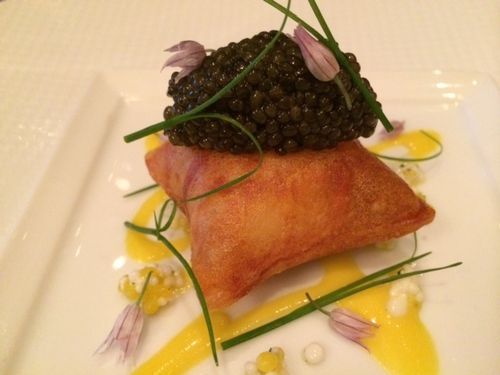
....and this remarkably intense truffle custard, nestled into an egg shell.
This is sumptuous indulgence on a very grand scale. You wouldn't want to get accustomed to eating like this. But every once in a while it's wonderful to be reminded that, somewhere in the world, some people are living the luxe life. It's nice to know you can join them if you're so inclined, for a short, sparkling interlude.
To me it was like going to a spa: the effects of this little sojourn have buoyed me up all week.
May 30, 2015
Dinner Last Night
On Thursday night, after a cocktail party for Book Expo, I found myself wandering the Columbus Circle Whole Foods supermarket in search of something to cook for dinner.
I looked at the soft shell crabs, but they seemed sad and exhausted. The steamer clams looked tempting, but I decided to peruse the butcher counter before committing.
And there it was: humanely raised veal from a local farm, glowing up at me. Rosy pink, it looked very seductive.
I've missed veal. I was raised by a Berlin-born man who considered Wiener Schnitzel one of life's major food groups. But modern veal, which is primarily a by-product of dairy farming, is problematic. Male calves are removed from their mothers soon after birth to keep them from drinking up the profits. They're fed a low iron diet, which keeps the meat white but is so unhealthy that the formula is generally laced with antibiotics. The result is pale, listless meat with no taste; there's no way you can feel good about eating it.
But this looked different. I couldn't resist.
I bought some beautiful pink veal, took it home, and cooked it quickly with lemons and capers. It was fantastic. My only worry is this: am I ever going to find this glorious veal again?
Veal with Lemon and Capers
1 pound veal scaloppine, cut from the leg
flour
salt
pepper
2 tablespoons olive oil
2 tablespoons butter
1 lemon
1/4 cup chicken stock
squeeze of lemon juice
Put each piece of veal between two pieces of wax paper and pound with a heavy object (I use a rolling pin), until it is very thin.
Spread a good handful of flour on a plate, add a fair amount of salt and a few grinds of pepper. Dredge each piece of veal in the flour, and put on a plate to dry out a bit.
Cut the ends off the lemon, then slice off the rind. Remove the seeds and cut the peeled lemon into eight segments.
Melt the olive and butter, over high heat, in a large skillet. Cook the veal, in stages, about 1 minute on each side, and remove to a large platter.
Deglaze the pan with the chicken stock and lemon juice, scraping up the brown bits. Add the lemon pieces and boil down until the lemon has gone soft and the liquid is reduced in half; it should only take a couple of minutes. Turn the heat down, add the veal and capers to the pan, turn to coat the meat, add another tablespoon of butter and stir until the sauce is slightly thickened and serve to four people.
I like to served this on rice, to soak up all that delicious sauce.
May 28, 2015
Covers III
Thanks everybody, for your comments on Comfort me with Apples. I have to admit that when I started reading comments on Amazon like, "I wouldn't want my children to know this woman," I was taken aback. But then the sixties, seventies, pre-Aids world was a very different place.
On to Garlic and Sapphires, which has been my most popular book.
The original jacket, which we copied from a picture taken at Gotham Bar and Grill for an article in Newsweek when I first got to the New York Times, is of a waiter holding a plate of pasta so that it obscures my face. The wonderful Romulo Yanes shot it in Gourmet's studio at 4 Times Square. I've always liked it.
But other countries, other covers. Here are a few:
The Norwegian hardback edition reprised the American cover, although the colors are decidedly more garish.
Thai version - lovely little line drawings on each chapter opening (by the same artist who did the cover).
I don't speak Hebrew, so I don't know why the Israeli version has a man on the cover. But they do make up for it, by having a HUGE photograph of me, split, divided between the flaps.
Chinese version, in paperback. But this is actually a jacket. Take it off and what is revealed is.....
an onion!
British edition. A bit literal, but in a good way. The restaurant always reminds me of Torrisi Italian Specialties.
Brazillian edition. They are consistent. (See Comfort me with Apples.)
The German edition which was, briefly and implausibly, a best-seller. The title , which translates literally as "fake rabbit," is the German word for meatloaf and a slang expression for a counterfeiter. Kind of a great title translation.
And finally, my all-time favorite. This Complex Chinese version uses two pictures of me taken by Josef Astor for an article in More Magazine. This picture, where I'm dressed in my mother's clothes, is one of the few pictures I have of me in disguise.
May 27, 2015
A Book and its Cover, Part II
This is the book that's sold least-well of anything I've written. I've always wondered if it was because of the contents, which some people find risque, or because nobody's nailed the cover, in any language.
Original hardcover.
Korean version
Dutch version
Spanish version
Portuguese version
Ruth Reichl's Blog
- Ruth Reichl's profile
- 2980 followers


